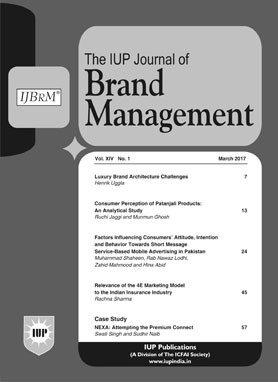
Dec'23
|
|
The IUP Journal of Brand Management
ISSN: 0972-9097
A "peer-reviewed" journal included in EBSCO and ProQuest (Part of Clarivate) Database
It is a quarterly journal that focuses on Brand equity, Brand image, Brand extension, Brand growth, Brand alliances and mergers; Corporate brand cocreation and Integrated brand communication; Product branding vs. Service branding; Retail branding; Branding for non-profit organizations; Brand metrics and Brand analytics; Brand research methods and Management strategies; Brand valuation.
Effects of Image, Identity and Reputation on Higher Education Brand Equity: A Study on Universities in Ghana
Branding has become a strong competitive weapon for universities, of late. Hence, this study sought to investigate the effect of university brand image, identity and reputation on higher education brand equity (HEBE) with specific reference to Ghana. This quantitative cross-sectional survey used Smart-PLS and a sample of 625 respondents. The results were analyzed using structural equation modeling (SEM) technique. All six hypotheses formulated were found to be positive and significant. Hence, university image and identity have significant positive influence on university brand equity (BE). Also, image and identity have significant positive effect on BE through university reputation. The originality of the study lies in the use of signaling theory to explain the role and effects of university image, reputation and identity on BE. The present study adds to the body of knowledge in the field of higher education service marketing and branding and offers insights into the essential factors involved in developing brand equity for higher education institutions. Policymakers can also benefit from the outcomes of this research.
Awareness of Secondhand Luxury Consumption Among Indian Consumers: A Qualitative Study
Secondhand luxury or resale of luxury goods has been gaining prominence across the world, allowing global fashion companies to adopt newer business models. The paper presents the various facts and concepts related to secondhand luxury by reviewing the pertinent literature. It provides a conceptual understanding of the secondhand luxury market, along with resale models adopted by a few luxury fashion companies. Besides, it addresses the purchase patterns of consumers through a qualitative survey, which comprised shopping patterns dimensions. The study highlights the marketing strategies, factors influencing secondhand luxury consumption, and sustainability issues related to the industry.
Case Study
Dishoom: Building a Distinct Restaurant Brand Using Storytelling and 'Seva' Culture
The case describes how the founders of Dishoom, a UK-based restaurant chain, created a distinct brand for themselves in the crowded restaurant market through a culture of quality and service and keeping employees happy. The case touches upon how the cofounder of Dishoom, Shamil Thakrar (Shamil), decided to get into a business that would rejuvenate the Indian culture in Britain. It describes Dishoom's focus on its menu and ambience inspired by the Irani cafes known for their affordably priced and delicious food. The case then focuses on Dishoom's internal strategy to keep its employees happy by providing training and support to them. This included wellness programs such as total distribution of service charges to employees, a 24-hour confidential counseling helpline, fully training managers in mental health first aid, as well as discounted memberships and classes and yoga sessions for the employees from local gyms and studios in the vicinity of each restaurant. The case ends with the founder's business expansion plans. During the Covid-19 pandemic lockdown, Dishoom diversified into the food delivery business and also ventured into the meal kit business.
Research Note
Gender-Specific Differences in Consumer Behavior and Best-Practice Examples of Gender Marketing in Brand Management
Understand your market and understand your customer are two basic rules of marketing. However, as markets become more complex and customers more demanding, working with these basic rules becomes a greater challenge to face in a networked and global world. Today, the majority of international markets can be characterized as buyers' markets. This means that the consumer is in a stronger position than the supplier. For the supplier, who faces stronger competition in a buyer's market, the bottleneck factor is not in the area of production, but rather in the area of marketing. As a result, suppliers face the challenge of market orientation in order to differentiate themselves from the competition and serve the market correctly according to its needs. Benefit and performance are no longer the only deciding factors in purchasing. The emotionality and credibility of a provider or brand are becoming increasingly important.